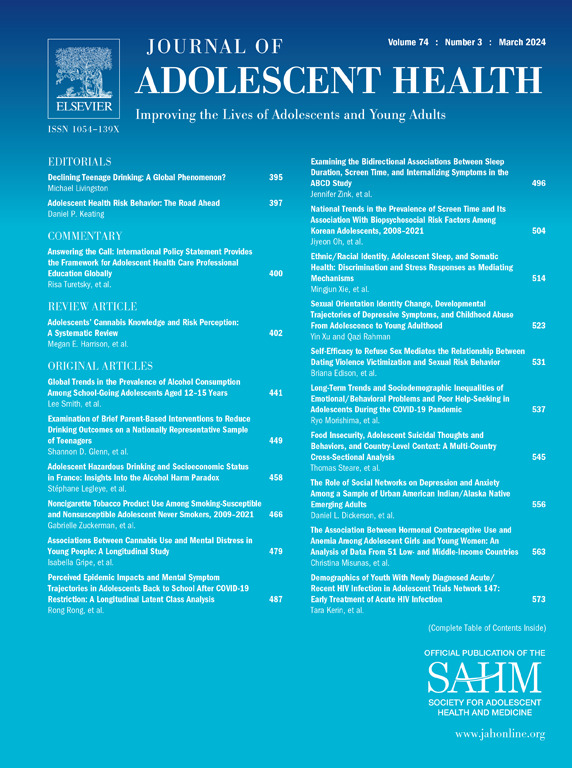2008年至2019年亚裔美国年轻人自杀想法和行为的全国趋势:性别和性身份的交集。
IF 5.5
2区 医学
Q1 PEDIATRICS
引用次数: 0
摘要
目的:关于亚裔美国人(AA)年轻人的性、性取向和自杀念头和行为(STBs)之间的交叉关系的研究文献不足。方法:分析全国药物使用与健康调查(2008-2019)的数据,重点分析18-25岁青少年(n = 8600),并将性别认同问题纳入2015-2019年的数据。共有268名(7.45%)受访者认为自己是女同性恋、男同性恋或双性恋。使用连接点回归分析来检查随时间变化的趋势,并使用预测建模来评估交叉身份对stb的影响。采用Logistic回归检验性传播感染与性别、性取向、性与性取向交叉的关系。结果:性病发病率呈上升趋势。联点回归分析显示,自杀念头、计划和企图显著增加,年变化百分比分别为3.34% /年(p = 0.03)、7.45% /年(p = 0.002)和7.52% /年(p = 0.04)。在性别认同上存在明显的差异:异性恋者患性传播疾病的趋势在所有性传播疾病患者中都是持平的,而在性少数群体中,自杀念头、计划和企图的年百分比变化分别为11.27% (p = 0.43)、42.4% (p = 0.06)和64.9% (p = 0.23),尽管这些增长在统计上没有显著性意义。讨论:制定有效的自杀预防策略或解决嗜酒者互戒会年轻人的心理健康差异是至关重要的,同时考虑到性取向和性少数身份的交集。本文章由计算机程序翻译,如有差异,请以英文原文为准。
National Trends of Suicidal Thoughts and Behaviors Among Asian American Young Adults Between 2008 and 2019: The Intersection of Sex and Sexual Identity
Purpose
There is insufficient literature examining the intersections among sex, sexual orientation, and suicidal thoughts and behaviors (STBs) among Asian American (AA) young adults.
Methods
Data from the National Survey of Drug Use and Health (2008–2019), focusing on AAs aged 18–25 (n = 8,600), were analyzed, with sexual identity questions included in the 2015–2019 data. A total of 268 (7.45%wt) respondents identified themselves as lesbian, gay, or bisexual. Joinpoint regression analysis was used to examine trends over time, and predictive modeling was used to assess the impact of intersecting identities on STBs. Logistic regression was used to test the association between STBs and sex, sexual orientation, and the intersection of sex and sexual orientation.
Results
Trends for STBs showed an upward trajectory. Joinpoint regression analysis revealed a significant increase in suicidal thoughts, plans, and attempts, with annual percentage changes of 3.34% per year (p = .03), 7.45% per year (p = .002), and 7.52% per year (p = .04), respectively. There was a clear disparity based on sexual identity: while trends for STBs among heterosexuals were flat across all STBs, for sexual minorities, the annual percentage changes for suicidal thoughts, plans, and attempts were 11.27% (p = .43), 42.4% (p = .06), and 64.9% (p = .23), respectively, although these increases were not statistically significant.
Discussion
It is crucial to develop effective suicide prevention strategies or address mental health disparities for AA young adults while accounting for the intersection of sex and sexual minority status.
求助全文
通过发布文献求助,成功后即可免费获取论文全文。
去求助
来源期刊

Journal of Adolescent Health
医学-公共卫生、环境卫生与职业卫生
CiteScore
10.40
自引率
3.90%
发文量
526
审稿时长
46 days
期刊介绍:
The Journal of Adolescent Health is a scientific publication dedicated to enhancing the health and well-being of adolescents and young adults. Our Journal covers a broad range of research topics, spanning from the basic biological and behavioral sciences to public health and policy. We welcome a variety of contributions, including original research papers, concise reports, literature reviews, clinical case reports, opinion pieces, and letters to the editor. We encourage professionals from diverse disciplines such as Anthropology, Education, Ethics, Global Health, Health Services Research, Law, Medicine, Mental and Behavioral Health, Nursing, Nutrition, Psychology, Public Health and Policy, Social Work, Sociology, and Youth Development to share their expertise and contribute to our mission of promoting adolescent health. Moreover, we value the voices of young individuals, family and community members, and healthcare professionals, and encourage them to submit poetry, personal narratives, images, and other creative works that provide unique insights into the experiences of adolescents and young adults. By combining scientific peer-reviewed research with creative expressions, our Journal aims to create a comprehensive understanding of the challenges and opportunities in adolescent and young adult health.
 求助内容:
求助内容: 应助结果提醒方式:
应助结果提醒方式:


